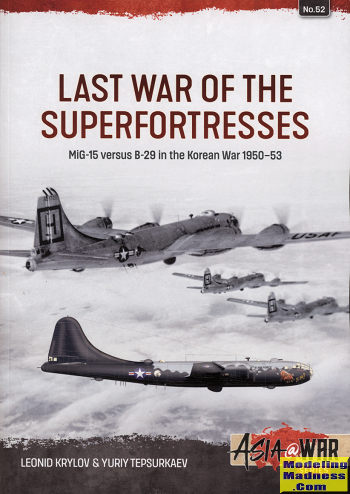 The US
entered the Korean war with what was basically a WWII arsenal of equipment, both
for land forces and in the air. Initially this worked quite well as the smaller
North Korean Air Force was equipped with Soviet piston engine fighters and
attack aircraft, such as the La-11 and the IL-10. It wasn't long before the
surprised and overwhelmed UN forces were pushed back. Thanks to McArthur's bold
landing at Inchon, the tide turned and the North Koreans were pushed back
towards the Chinese border.
The US
entered the Korean war with what was basically a WWII arsenal of equipment, both
for land forces and in the air. Initially this worked quite well as the smaller
North Korean Air Force was equipped with Soviet piston engine fighters and
attack aircraft, such as the La-11 and the IL-10. It wasn't long before the
surprised and overwhelmed UN forces were pushed back. Thanks to McArthur's bold
landing at Inchon, the tide turned and the North Koreans were pushed back
towards the Chinese border.
During all this time, the USAF waged a strategic bombing
campaign against North Korean infrastructure, basically destroying what little
manufacturing the north had alone with dropping bridges and dealing with rail
yards. The main player in this campaign were B-29s operating from Okinawa. Then
things changed. China and the Soviet Union got into the act. The Chinese sent
tens of thousands of troops across the border, while the Soviets sent not only
replacement aircraft for the North Koreans (which were now based in China), but
also Soviet MiG-15 units to Chinese bases in the general area. Their aircraft
were repainted in North Korean markings, but the pilots were highly experienced
pilots who had been successful against the Germans in WWII.
The MiG-15s were able to reach the operating altitude of
the B-29s and had a heavy enough armament to not only seriously damage the
Superfortress, but also knock some from the skies. Of course, this wasn't as
simple as it sounds. The B-29 was fairly fast and the MiGs had not only limited
fuel but also were lacking initially in decent ground control radar. Thus began
a three year battle where the Soviets improved their tactics/equipment and the
USAF followed suit with upgraded equipment and changed tactics, that eventually
saw most bombing raids in northern North Korea move to night operations. This
continued until the end of the war.
It is unusual for many of us to read a book on the
Korean war from the Russian side of things. This book does just that. It is
obvious from reading the book that the authors have done a lot of research into
the subject and they provide a look at this particular aspect of the war from a
fairly unique perspective. Some of their commentary and conclusions are
different than what western media has been providing for decades about the
conflict and I'll leave it up to the reader to reach their own conclusions about
these areas. It is quite unusual to me to read phrases about 'our aircraft' when
referencing MiG-15s, but I suppose that adds to the interest of the title. One
thing I did notice is that the editing seems a bit sloppy in spots as, for
instance, I found the same place names spelled in several different ways through
the book. The authors also call the Superfortress 'Fortress' and refer to it as
a medium bomber. Regardless, this is a very good book full of all sorts of
Soviet pilot stories and insights into Soviet operations during the war. I very
much enjoyed reading this perspective and I know you will as well.
September 2024
Copyright ModelingMadness.com. All rights reserved. No
reproduction in part or in whole without express permission.
Review book courtesy of
Casemate Publishers, where you can order your copy
at this
link.
If you would like your product reviewed fairly and quickly, please
contact the editor or see other details in the
Note to
Contributors.
 The US
entered the Korean war with what was basically a WWII arsenal of equipment, both
for land forces and in the air. Initially this worked quite well as the smaller
North Korean Air Force was equipped with Soviet piston engine fighters and
attack aircraft, such as the La-11 and the IL-10. It wasn't long before the
surprised and overwhelmed UN forces were pushed back. Thanks to McArthur's bold
landing at Inchon, the tide turned and the North Koreans were pushed back
towards the Chinese border.
The US
entered the Korean war with what was basically a WWII arsenal of equipment, both
for land forces and in the air. Initially this worked quite well as the smaller
North Korean Air Force was equipped with Soviet piston engine fighters and
attack aircraft, such as the La-11 and the IL-10. It wasn't long before the
surprised and overwhelmed UN forces were pushed back. Thanks to McArthur's bold
landing at Inchon, the tide turned and the North Koreans were pushed back
towards the Chinese border.